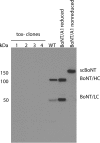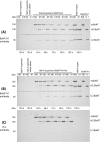Holotoxin Activity of Botulinum Neurotoxin Subtype A4 Originating from a Nontoxigenic Clostridium botulinum Expression System
- PMID: 25239905
- PMCID: PMC4249187
- DOI: 10.1128/AEM.01795-14
Holotoxin Activity of Botulinum Neurotoxin Subtype A4 Originating from a Nontoxigenic Clostridium botulinum Expression System
Abstract
Clostridium botulinum subtype A4 neurotoxin (BoNT/A4) is naturally expressed in the dual-toxin-producing C. botulinum strain 657Ba at 100× lower titers than BoNT/B. In this study, we describe purification of recombinant BoNT/A4 (rBoNT/A4) expressed in a nonsporulating and nontoxigenic C. botulinum expression host strain. The rBoNT/A4 copurified with nontoxic toxin complex components provided in trans by the expression host and was proteolytically cleaved to the active dichain form. Activity of the recombinant BoNT/A4 in mice and in human neuronal cells was about 1,000-fold lower than that of BoNT/A1, and the recombinant BoNT/A4 was effectively neutralized by botulism heptavalent antitoxin. A previous report using recombinant truncated BoNT/A4 light chain (LC) expressed in Escherichia coli has indicated reduced stability and activity of BoNT/A4 LC compared to BoNT/A1 LC, which was surmounted by introduction of a single-amino-acid substitution, I264R. In order to determine whether this mutation would also affect the holotoxin activity of BoNT/A4, a recombinant full-length BoNT/A4 carrying this mutation as well as a second mutation predicted to increase solubility (L260F) was produced in the clostridial expression system. Comparative analyses of the in vitro, cellular, and in vivo activities of rBoNT/A4 and rBoNT/A4-L260F I264R showed 1,000-fold-lower activity than BoNT/A1 in both the mutated and nonmutated BoNT/A4. This indicates that these mutations do not alter the activity of BoNT/A4 holotoxin. In summary, a recombinant BoNT from a dual-toxin-producing strain was expressed and purified in an endogenous clostridial expression system, allowing analysis of this toxin.
Copyright © 2014, American Society for Microbiology. All Rights Reserved.
Figures




Comment in
-
Botulinum Neurotoxin Subtype A4 Originating from Nontoxigenic Clostridium botulinum.Appl Environ Microbiol. 2014 Dec;80(23):7131-2. doi: 10.1128/AEM.03001-14. Epub 2014 Sep 19. Appl Environ Microbiol. 2014. PMID: 25239910 Free PMC article. No abstract available.
Similar articles
-
Botulinum Neurotoxin Subtype A4 Originating from Nontoxigenic Clostridium botulinum.Appl Environ Microbiol. 2014 Dec;80(23):7131-2. doi: 10.1128/AEM.03001-14. Epub 2014 Sep 19. Appl Environ Microbiol. 2014. PMID: 25239910 Free PMC article. No abstract available.
-
Potency Evaluations of Recombinant Botulinum Neurotoxin A1 Mutants Designed to Reduce Toxicity.Int J Mol Sci. 2024 Aug 17;25(16):8955. doi: 10.3390/ijms25168955. Int J Mol Sci. 2024. PMID: 39201641 Free PMC article.
-
Catalytic properties of botulinum neurotoxin subtypes A3 and A4.Biochemistry. 2009 Mar 24;48(11):2522-8. doi: 10.1021/bi801686b. Biochemistry. 2009. PMID: 19256469 Free PMC article.
-
Purification, modeling, and analysis of botulinum neurotoxin subtype A5 (BoNT/A5) from Clostridium botulinum strain A661222.Appl Environ Microbiol. 2011 Jun;77(12):4217-22. doi: 10.1128/AEM.00201-11. Epub 2011 Apr 22. Appl Environ Microbiol. 2011. PMID: 21515732 Free PMC article.
-
Exploring the role of botulinum toxin in critical care.Expert Rev Neurother. 2021 Aug;21(8):881-894. doi: 10.1080/14737175.2021.1958678. Epub 2021 Aug 9. Expert Rev Neurother. 2021. PMID: 34281468 Review.
Cited by
-
Purification and Characterization of Botulinum Neurotoxin FA from a Genetically Modified Clostridium botulinum Strain.mSphere. 2016 Feb 24;1(1):e00100-15. doi: 10.1128/mSphere.00100-15. eCollection 2016 Jan-Feb. mSphere. 2016. PMID: 27303710 Free PMC article.
-
Botulinum neurotoxin-encoding plasmids can be conjugatively transferred to diverse clostridial strains.Sci Rep. 2018 Feb 15;8(1):3100. doi: 10.1038/s41598-018-21342-9. Sci Rep. 2018. PMID: 29449580 Free PMC article.
-
Immunoprecipitation of native botulinum neurotoxin complexes from Clostridium botulinum subtype A strains.Appl Environ Microbiol. 2015 Jan;81(2):481-91. doi: 10.1128/AEM.02817-14. Epub 2014 Oct 31. Appl Environ Microbiol. 2015. PMID: 25362065 Free PMC article.
-
In vivo onset and duration of action varies for botulinum neurotoxin A subtypes 1-5.Toxicon. 2015 Dec 1;107(Pt A):37-42. doi: 10.1016/j.toxicon.2015.06.021. Epub 2015 Jun 27. Toxicon. 2015. PMID: 26130522 Free PMC article.
-
The Light Chain Defines the Duration of Action of Botulinum Toxin Serotype A Subtypes.mBio. 2018 Mar 27;9(2):e00089-18. doi: 10.1128/mBio.00089-18. mBio. 2018. PMID: 29588398 Free PMC article.
References
Publication types
MeSH terms
Substances
Grants and funding
LinkOut - more resources
Full Text Sources
Other Literature Sources
Medical

